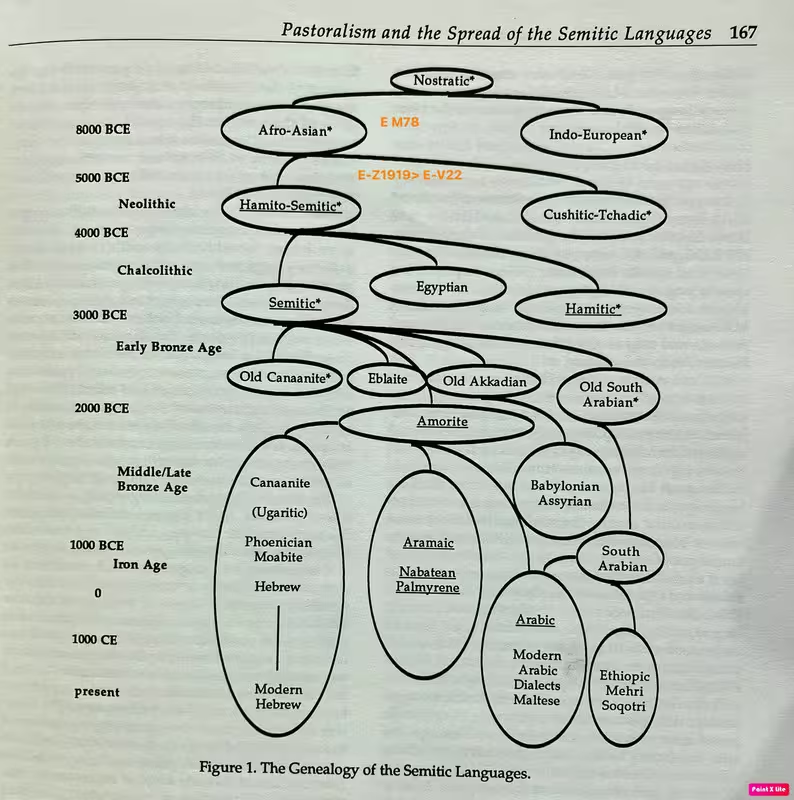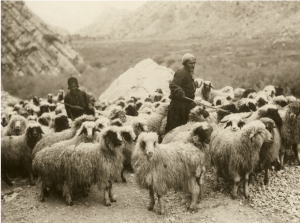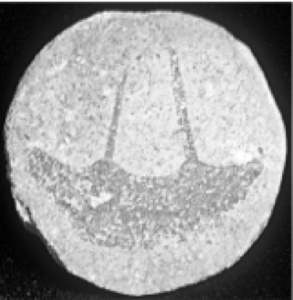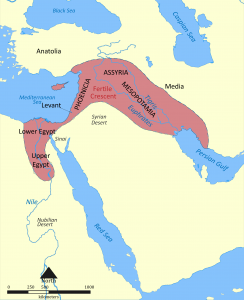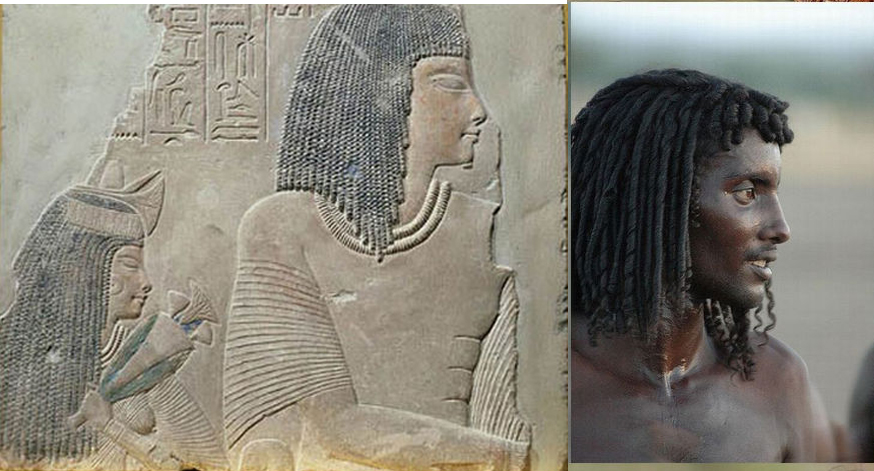Spread of the Levantine Pastoralist
Work at the site of ‘Ain Ghazal in Jordan has indicated a later Pre-Pottery Neolithic C period, which existed between 8,200 and 7,900 YPB, which is congruent with the split of E-V22 from fatherclade E-Z1919.
Ilse Köhler Rollefson (1991) about the Jordanian area (‘Ain Ghazal): ” “Some of the strongest archeological evidence for the first occurrence of pastoral nomadism during the PPNC:8000 (8000 BC-7500 BC) are the findings of Andrew Garaard’s Azraq Basisn Project (Garrard et al 1988). He located an excavated in the easter desert that ranged from Epipaleothic to the Pottery Neolithic and he found that caprovids first appear round 8250 YBP. This suggests that caprovids were not part of the indigenous fauna of the eastern desert but were introduced there, only after they had been domesticated in the permanent settlements in the margins of the highlands to the west.”
Juris Zarins has proposed that a Circum Arabian Nomadic Pastoral Complex developed in the period from the climatic crisis of 8200 YPB, partly as a result of an increasing emphasis in PPNB cultures upon animal domesticates, and a fusion with Harifian hunter gatherers in Southern Palestine, with affiliate connections with the cultures of Fayyum and the Eastern Desert of Egypt. Cultures practicing this lifestyle spread down the Red Sea shoreline and moved east from Syria into southern Iraq. (wiki)
Into Egypt
Allison Smith Unraveling the prehistoric ancestry of the present-day inhabitants of Northeast Africa: An archaeogenetic approach to Neolithisation (2013).
“The prime Northeast African haplogroup E candidate related to the arrival of farmers and/or pastoralists from the Levant is undated E-M34. E-V12(xV32) and E-V22 may well represent local adaptation”
Ofer Bar-Yosef, Nile Valley-Levant interactions: An eclectic review (same bundle as Smith 2013). In the case of E-V22 and pastoralists, PPNC is of primary interest:
“The next phase of migration by farmers bringing goats and later sheep into Egypt took place after the “8200 cal BP cold event” (c.6200cal BC).
…
The Egyptian Neolithic that dates to the 6th millennium BC provides a wealth of evidence for the connections with the Levant partially due to inward migration of small groups as indicated by the genetic evidence (see Alison Smith, this volume).
The Levantine origins of the bifacial projectiles and knives were already suggested by more than one study (e.g. Wetterstrom 1993; Shirai 2010 andreferences therein). Movements of Levantine groups were probably the mechanism that brought cattle, goat and sheep to the Nile valley.”
Last but not least: Shayla Monroe, Stuart Tyson Smith , Sarah B. McClure, Pastoralism, hunting, and coexistence: Domesticated and wild bovids in Neolithic Sudan (2023):
“By 6000 BC, these Nile Valley subsistence strategies began to accommodate the initial influx of caprines from Southwest Asia (Wengrow et al., 2014)”
Into Mesopotamia
Again Juris Zarins in Early Pastoral Nomadism and the Settlement of Lower Mesopotamia (1990) : ‘The Akkadians’ nomadic origins have generally been assumed. However, the conventional prehistoric archaeological picture fails to illuminate those origins and the Akkadians’ involvement in Akkad.
Thus the origins of pastoral nomadism must be sought in the context of mixed farming within the Fertile Crescent, specifically during the PPNB. Subsequent expansion into marginal agricultural lands led to a symbiotic relationship between pastoral nomads and farmers. The Akkadians seem to have moved into the northern Arabian steppe and desert (Jezireh and Hamada) during the mid-seventh millennium B. C.; the PPNB/C populations apparently began intensive herding at the end of that period, and maintained ties to the Fertile Crescent seen in both exotic trade and everyday culture.
They began to penetrate into Akkad during the time under discussion. Archaeological sequences in the Arabian desert suggest that the Akkadians probably were of a West Semitic (Levantine) background. Thus, the alluvium in the Akkadian area became a distinct entity as early as ca. 8000 YBP and represented the early prehistoric forerunners to Akkadians of the fourth and third millennia B. C.’
The Neolithic of the Levant was close linked tot he Ubaid culture in Mesopotamia. M. Redha Bhacker and Bernadette Bhacker: “Oman’s early settlers were Neolithic pastoralists and seafaring people who worked trade routes from Mesopotamia to the Indus Valley. Arrowheads found in Qatar in 1960 by Danish prehistorian Holgar Kapel and ash from ancient campfires found in Muscat in 1983 are the earliest evidence of the nomads who followed their flocks south from the Levant, settling the Arabian peninsula 8,000 years ago. Remains of Neolithic camps found during the past three decades suggest that as Arabia’s climate became wetter, these herders thrived, roaming in widely dispersed groups from Syria and Iraq in the north to Dhofar in southern Oman.”
Alicia M Cadenas (2008): “Recent archaeological finds supports a trading relationship between Mesopotamia and the Arabian Gulf region dating back to the Al Ubaid Period (~7000 ybp) as evidenced by the excavation of Ubai pottery from Mesopotamia in UAE. Ancient maritime trade routes linking Mesopotamia to the Indus Valley included Dilmun (the island of Bahrain) and Magan (in the southeastern tip of the Arabian Peninsula). It is possible hat the close ties between Mesopotamia with both the Nile River Valley and the ancient Persian Gulf region during the Neolithic helped disseminate these haplogroups.” In casu: E-V22.
Image: fertile crescent
Into the Horn of Africa
The E-V22 spread had his highest impact in the Horn of Africa. Due to the so called Savannah Pastoral Neolithic (5200-3300 ybp) E-V22 spread from Nubia/Kush to the Horn of Africa. In the most Eastern part of the Horn of Africa among the “Cushites” and closer to the outmost upper Nile Valley among the “Nilotic”. Tribes with the highest E-V22 are Saho, Eritrea (88%), Turkana Kenya (33%) Fulani, Sudan (30%), Beja, Eritrea (30%),Gurage, Ethiopia (29%), Masaai, Sudan, (16%).
The nowadays Saho men of Eritrea have 88% E-V22. They are not only a representative of a major founder effect of in the end Levantine pastoralist their name means literally pastoralist. “The word “Saho” means “nomad,” (“saa” means animals and “hoo” means caretaker), which is also an expression of their previous pastoral way of life. ” So E-V22 is probably rooted along “6000 BC to form what Juris Zarins calls the Syro-Arabian pastoral technocomplex, which saw the spread of the first Nomadic pastoralists in the Ancient Near East.” a torch still carried by the Saho.
To make the puzzle complete: there is most probably a big coherence in the rise and spread of pastoralism- and semi-nomadic lifestyle- from the Southern Levant, the ‘birth’ of E-V22 (out of E-Z1919) and the proto-Semitic language at about 8000 YBP (6000 BCE) and later on. these parts of the puzzle can be completed with other puzzle pieces: linguistics. More specific: (proto) Semitic.
Departure point in this respect is the monograph, Pastoralism in the Levant (1992). In which there is a magnificient contribution of Mattanayah Zohar, Pastoralism and the spread of Semitic languages. This contains some reference to Joseph Henninger, Zum frühsemitischen Nomadentum (1969).
Zohar (1992) states: “The simultaneous appearance of mobile pastoralism and Semitic language does not necessarily mean that the two are connected but the probability is very high. All the reasons combined seem to make a good case for the spread of probably relative small mobile groups of pastoralists speaking Old Semitic into the Near East.
The limited historical sources in our possession show that the pastoralists were undoubtedly Semitic (Henninger 1969). Also the ruling class in the newly established Middle Bronze Age towns and cities of Syria-Palestine were predominantly Semitic according to names supplied by Egyptian sources.”
…
“Without assuming an “ethnic struggle” in the modern sense of the word, it seems to be clear that it was the constant pressure of the semi-nomadic pastoralists which led to the dominance of the Semitic languages in the Levant. The grand theme of Near Eastern history, the struggle between the Desert and the Sown, can also be followed in linguistic terms. The time-honored view of many scholars, seeing the renewal of Semitic peoples if the Fertile Crescent in the ever repeating waves of pastoral nomads and semi-nomads appearing out of the desert in various degrees of strength and settling in the fertile areas, appears to have been correct, after all.”
The summary of it is in this image of the Zohar paper, I have added the E-M78 and E-Z1919>E-V22 (placed in their timing).
